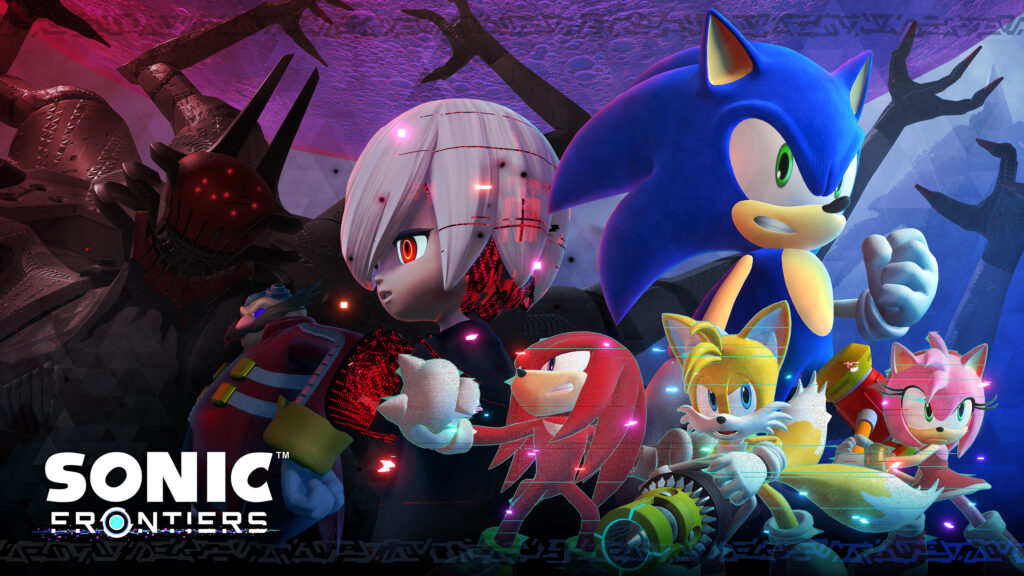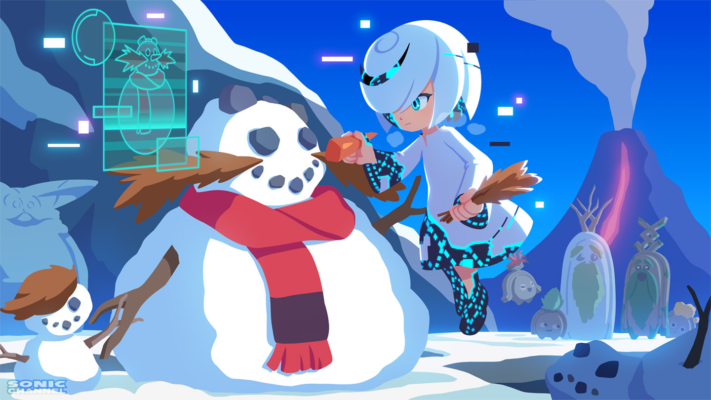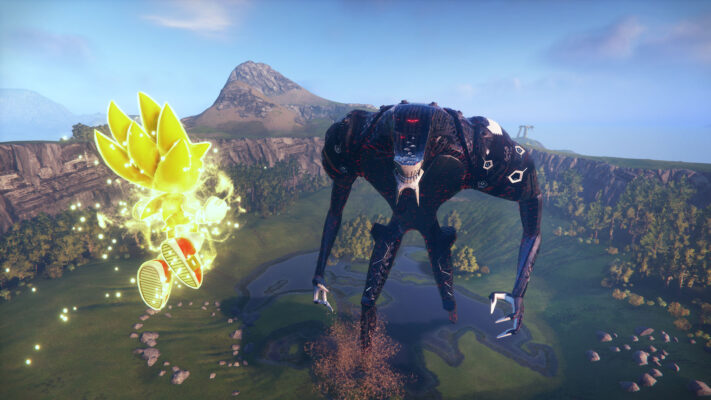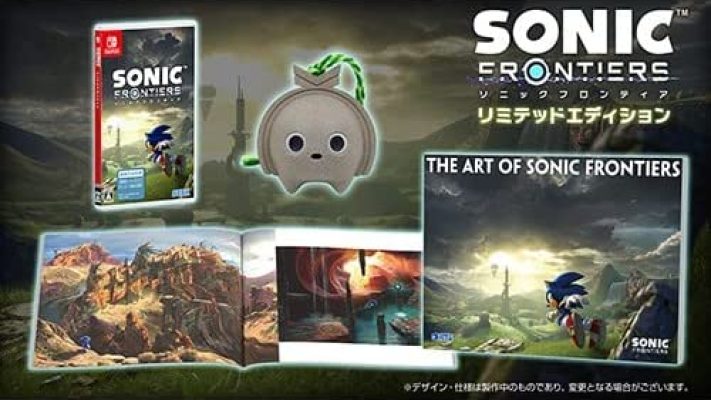Sonic Frontiers, released on November 8, 2022, features expansive open zones where Sonic races.
Speed, the thrill of racing through beautiful grasslands, well-placed and satisfyingly rhythmic gimmicks, ancient ruins, a mysterious girl, and colossal end-of-area bosses – Sonic Frontiers retains the appeal of the Sonic franchise while expanding and deepening its gameplay.
This new take on 3D Sonic has been highly praised since its release in November 2022. It has surpassed 3.5 million copies sold worldwide*, and it was awarded the Excellence Award at the Japan Game Awards 2023 during the Tokyo Game Show.
Creating something new while preserving the charm of Sonic, one of the top characters and brands in gaming, was challenging. The effort has been rewarded with both sales figures and critical acclaim.
The final free update for Sonic Frontiers was rolled out at the end of September 2023. It added a substantial volume to the game, seemingly as if an entirely new island (field) was introduced, accompanied by more challenging enemies and bosses.
So, what has Sonic Frontiers pioneered? How was the free large-scale downloadable content ‘Super Final Battle’(Japanese name for The Final Horizon update) created? Let’s dive into the numbers and ask the director and producer for insights.
* The sales figures are as reported by Sega.
Morio Kishimoto

Sega Director (referred to as Kishimoto in the text)
After working in the development of arcade video games, he joined Sonic Team. He has worked on various titles in the Sonic series, starting with Sonic and the Secret Rings released for the Wii.
Sachiko Kawamura

Sega Producer (referred to as Kawamura in the text)
An artist who has been with the Sonic Team for a long time. She was responsible for the design of the Chao in Sonic Adventure on the Dreamcast. Sonic Frontiers is her first produced work.
Sonic Frontiers Celebrates Its First Anniversary! A Look Back at the Past Year
―― Sonic Frontiers, has sold 3.5 million copies worldwide… that’s a significant number, isn’t it?
Kawamura: Well, to be honest, we want to sell even more. We believe we can.
―― Oh, I see.
Kishimoto: Sonic Frontiers achieved sales of 2.5 million copies in the first four weeks.
In the Sonic series, it’s not unusual to reach a cumulative total of 2.5 million copies, but to achieve this within four weeks is a record at lightning speed.
I think this is also because many people immediately picked up the game after it was released. We had hoped it would turn out this way, so we’re honestly delighted.
Kawamura: The way the numbers are increasing is different from our previous titles, and Sonic games tend to sell for a long time. So, I don’t think 3.5 million copies is particularly significant for Sonic.
―― There’s still more potential for growth, isn’t there?
Kawamura: Yes, there is. It’s difficult to recommend a game released a year ago to people who haven’t played it yet. But many players have been talking about Sonic Frontiers thanks to the regular updates, and “The Final Battle” has just been released, so there’s a chance to play it. So please do.
Related Article:
―― The Sonic series has traditionally been more popular in North America and Europe than in Japan. How was it for this game?
Kawamura: As you’ve mentioned, that’s true, and this game also had higher sales in North America and Europe. However, we developed a strategy to sell Sonic in Japan and designed the game with that in mind.
Due to this approach, the current sales in Japan are about 3.5 times higher than the previous title.
―― 3.5 times!?
Kawamura: While the original numbers weren’t very large (laughs), I think it’s because Japanese players, especially those who haven’t been interested in Sonic before, have been playing the game.
Kishimoto: One of the goals of Sonic Frontiers was to create a game that appeals to Japanese game fans. We’re very grateful to Producer Kawamura because they promoted the game, taking into account not only Western audiences but also Japan.
We aimed to design the game, taking Japan into account from the beginning, and we’ve proven that we can increase sales in Japan. This is a significant step forward.
―― Winning the Japan Game Awards’ Excellence Award also helped to reach Japanese gamers. Were there any other goals you aimed for?


Related Article:
Kishimoto: When Sonic Team proposes a new mainstream Sonic title to the world, in the projects I direct, I’ve always thought, “The latest installment should be the best Sonic game.”
In this title, I had a goal beyond that, which was to resonate with gamers who love action games worldwide, including Japan. In that sense, this positive reception is much appreciated.
―― Were there any aspects that you felt you couldn’t achieve?
Kishimoto: We proposed free updates for Sonic Frontiers to make it even more enjoyable, including the first and second updates. With the third update, we even added a whole new open zone, the biggest one yet, and a final boss battle.
This was only possible through cooperation with our players, and I believe it became an even more substantial update than what I initially imagined.
However, I wonder how those who haven’t bought the game yet perceive this. What’s missing for them? Why hasn’t it resonated with those who haven’t bought it?
―― “Super Final Battle” indeed has an incredible volume, and it’s free.
Kishimoto: Since I worked relentlessly on it, I’m aware that there are some rough parts. I would like to receive messages, whether it’s the recognition of the Game Awards’ Excellence Award or the reputation of the final update, from those who haven’t played yet, saying, “This part is lacking; this needs more refinement.”
I believe there’s still a long way to go, so I want to push forward with this vision, trying to understand why people might not be playing it, why they don’t find it appealing, and address that by reaching out to gamers worldwide.
―― You want people who haven’t played Sonic to play it more and more.
Kishimoto: When I thought about what’s missing when trying to appeal to gamers, I’d like to know if there’s something lacking in Sonic Frontiers compared to titles like The Legend of Zelda: Tears of the Kingdom or Armored Core VI.
―― Really?
Kishimoto: I want to do everything I can to get involved with the game known as Sonic. I believe that Sonic is a title that can reach beyond just fans of Sonic, and we challenged that in Sonic Frontiers. We received some positive responses, but there are still aspects that didn’t resonate, so I’d like to gain insights into what those might be.
―― What Ms. Kawamura mentioned earlier – it connects to the idea that “there’s more room to grow.” You want more people to know about it and play it. How about you, Ms. Kawamura?
Kawamura: I always wanted to sell it in Japan from the beginning, so it’s great that we were able to expand our numbers in Japan.
As for how we tried to achieve this, there was a theme of “evolving Sonic.” I felt a kind of stagnation that came from having Sonic as an established series for so long, and I thought, “We have to change things here!”
During development, there was a lot of pain in giving birth to this new Sonic. However, we believe that Sonic fans accepted our proposal for the “evolved next-generation Sonic,” and people who weren’t Sonic fans also played it. So, I think that’s where we achieved the most.
If you ask what we couldn’t achieve, it’s in the area of “We could have gone further!” (laughs).
―― Are there any thoughts like “I should have tried this approach more” or something of that sort?
Kawamura: Yes, there are many (laughs).
Being a producer for the first time, I was in a trial-and-error situation, not sure of what I could do and what I should do. In that sense, there are moments where I think, “If there’s a next time, I could do it better.”
―― Specifically, what kind of thoughts?
Kawamura: Regarding how we wanted to sell it, whom we wanted to appeal to, I had quite close communication with the Japanese PR team. However, there are unique theories in Europe and North America, and I wish we could have delved deeper into that.
―― Maybe you could have pushed your opinions more when it comes to how to sell it in the West?
Kawamura: Now, looking back, I think the goal we wanted, which was “to appeal not only to Sonic fans but also to gamers,” was the same in both Japan and the West. Although people said that “there’s a different culture in the West,” I think we could have had a more gamer-focused approach.
―― Listening to the conversation, I once again realized that the title “Sonic Frontiers” has a nice meaning – that of challenging new frontiers and evolving. How was the title decided?
Kawamura: Right from the start, we wanted a unified title worldwide. So, we discussed ideas within the development team and talked with Iizuka-san, the series producer. Iizuka-san, having spent a long time in the United States, proposed, “How about ‘Frontiers’?” He selected words carefully to convey the intended nuance in English-speaking regions.
Nearly a Year of Free Updates Completed
――How were the three updates carried out over the course of about a year?
Kishimoto: As I mentioned earlier, achieving 2.5 million sales in the first four weeks after release set a record for the Sonic series in terms of speed. Seeing that momentum, the decision to continue with updates was made by Producer Kawamura and the higher-ups.
Originally, plans for updates were in place even before the release, but initially, they were expected to be more compact, focusing on seasonal events like Halloween. Being able to provide such extensive updates that significantly evolved the game, enriching the gameplay—a proactive approach—was made possible thanks to everyone’s support.
――It seems the positive reception from players and the good sales figures played a role.
Kishimoto: Yes, indeed.
Kawamura: The biggest challenge for this title was whether the new Sonic title, Sonic Frontiers, would be accepted by the fans. The fact that it was accepted was significant.
Also, Sega values the relationship with the fan community, so updating the game in close collaboration with the community is something the company encourages.
However, allowing such large-scale free updates was a substantial decision.
――I was surprised, having played it, that this was not paid DLC but a free update. Was the company’s approach to valuing fan support and the fan community the reason for conducting such significant updates regularly?
Kawamura: Yes, that’s right. The perspective in the gaming industry is shifting from selling and concluding to building a relationship based on responding to the voices of fans. The ability to download and patch games has significantly changed the landscape.
The trend is moving towards treating console games more like service titles, and looking at this situation, Sonic, with its large fan community, is highly valued. The company emphasizes how much it can appeal to this community and provide services to it.
――On October 17, 2023, the latest title, Sonic Superstars, was also released. Was this developed concurrently with Sonic Frontiers?
Kawamura: Sonic Superstar is being developed by our cooperating company, Arzest. It’s not an in-house project.
However, my mentor and the original designer of Sonic, Mr. Naoto Ohshima, is involved in the company working on it. He teamed up with Mr. Iizuka, the series producer, and they are creating it together.
――Recently, there has been about one new Sonic game per year, hasn’t there? Does this have to do with retaining the community, as mentioned earlier?
Kawamura: In the past few years, there has been a significant increase in enthusiasm within the company to focus on Sonic as an intellectual property (IP), especially with the release of the live-action movie.
If you look at the Sega booth at the Tokyo Game Show from last year and this year, you’ll see a tremendous emphasis on Sonic. Following this trend, the company has the intention to enrich the number and lineup of titles and continue to build excitement.
――Certainly, it’s not the case that there will be a release pace of about one per year in the future, is it?
Kawamura: Developing at a pace like Yakuza, releasing one per year, is a very challenging endeavor. I think that’s quite impressive.
――(Laughs) Looking back at 2022, both Sonic Origins and Sonic Frontiers were released in June and October, right?
Kawamura: Sonic Frontiers was a long-term project that set out the significant challenge of evolving Sonic, so there were quite a few twists and turns from the start of development until the release date was decided.
So, the schedule change happened with Sonic Frontiers (laughs). However, we were grateful to be allowed to take on such a challenge, so in that sense, it was a very appreciated project.
――On September 29, 2023, the third major free update, “Super Final Battle”, was released, marking the successful conclusion of updates spanning almost a year since the game’s release. What are your current thoughts?
Kawamura: It was a long project, so now that it’s finished, I feel relieved. It was a title that involved various challenges and achieved various results.
Both Director Kishimoto and I have been involved with Sonic for a long time, but this title, in particular, received recognition from game fans in Japan, becoming a memorable title for everyone. It was quite an achievement to leave such a strong impression, especially considering the many titles we’ve worked on over the years.
――Did you particularly feel that way in terms of the updates?
Kawamura: Yes, indeed. The fact that we offered free updates for a year after the release was a first for Sonic, and with each release, we received significant responses. So, I felt that there were many instances where we could feel the results.
――How about Mr. Kishimoto?
Kishimoto: Over the past year, we’ve conducted updates three times after the release, and it was truly enjoyable.
Of course, there were enjoyable moments while creating the product version, but the year of updates was filled with nothing but enjoyment. On the flip side, it was tougher than when we were creating the product version (laughs).
The impression after completing the final update is, “It was tough, but insanely fun.”
――Could you share what parts of the development were enjoyable and challenging?
Kishimoto: During the production of the updates, I started using Twitter after seeing Nakamura, the producer of the previous title Sonic Forces, doing a countdown to the release. Through Twitter (now X), I received various impressions, opinions, and requests from fans. It became clear what customers were expecting for the initially planned three updates.
In response, thinking about how Sonic Team and I would interpret and output what the customers were expecting was entirely different from my previous approach to game development.
Receiving daily messages and figuring out how to interpret them, we were guided by, “Ah, there are such perspectives, approaches, and ideas.” While working on the updates for Sonic Frontiers, we observed how the game evolved with each interpretation.
In the main production, it was a struggle throughout the production process, but this time around, there was a joy in nurturing what had been created. There were surprises like, “It became this much fun!” It was really enjoyable… so much fun.
――(Laughs) What was challenging?
Kishimoto: Initially, the updates were planned to be a bit more modest. The initially planned content was by no means inferior to that of other titles, but the impressions and opinions from everyone were so captivating that I ended up consulting with the team a lot, saying, “If we do this, it will definitely be interesting!”
As a result, it was a bit like tightening the noose around my own neck… turning into a major project beyond what was initially planned (laughs). There were cries from the team like, “Kishimoto-san, we didn’t plan to go this far, did we!?” However, there was still a lot of potential in the open zones, and we decided to go with the feeling of, “This isn’t trial and error; if we do it, it will definitely be interesting.”
Then, everyone on the team became positive and said, “Let’s do it!” It was really tough but also a fulfilling year.

――Miss Kawamura, you didn’t put any brakes on things in your role as a producer, did you?
Kawamura: Not at all (firmly).
――Powerful.
Kawamura: So, when Director Kishimoto says, “We may have gone too far,” I’m saying, “It was all according to plan from the beginning” (laughs).
Since we chose to communicate with fans through the game and listen to their feedback, there was no reason to stop that. I don’t want to say we should stop, but externally, I’d like to say, “It went exactly as planned!”
――I see (laughs).
Kishimoto: There were challenging aspects, but as a fundamental principle, we absolutely met the deadlines. It’s almost too obvious as a professional, but we definitely adhered to that.
――Ah, the volume increased more than initially expected, but it stayed within the calculated workload in Kishimoto-san’s mind and expanded to the maximum extent.
Kishimoto: Yes, for example, I didn’t have the idea to expand it by delaying the timing of the update delivery.
However, the Sonic team and I encouraged each other to go the extra mile and do what we could, even if it wasn’t originally planned. It’s not about doing things randomly but pushing ourselves to achieve more if possible.
Kawamura: There were no requests like “We want to extend the development period.” The team figured out how to manage within their capacity, and despite that, the development staff worked even harder than expected.
――As a producer, you didn’t apply the brakes there; instead, you provided support.
Kawamura: Yes, that’s correct. I was in more of an overseeing role.
Free Update 3: Super Final Battle
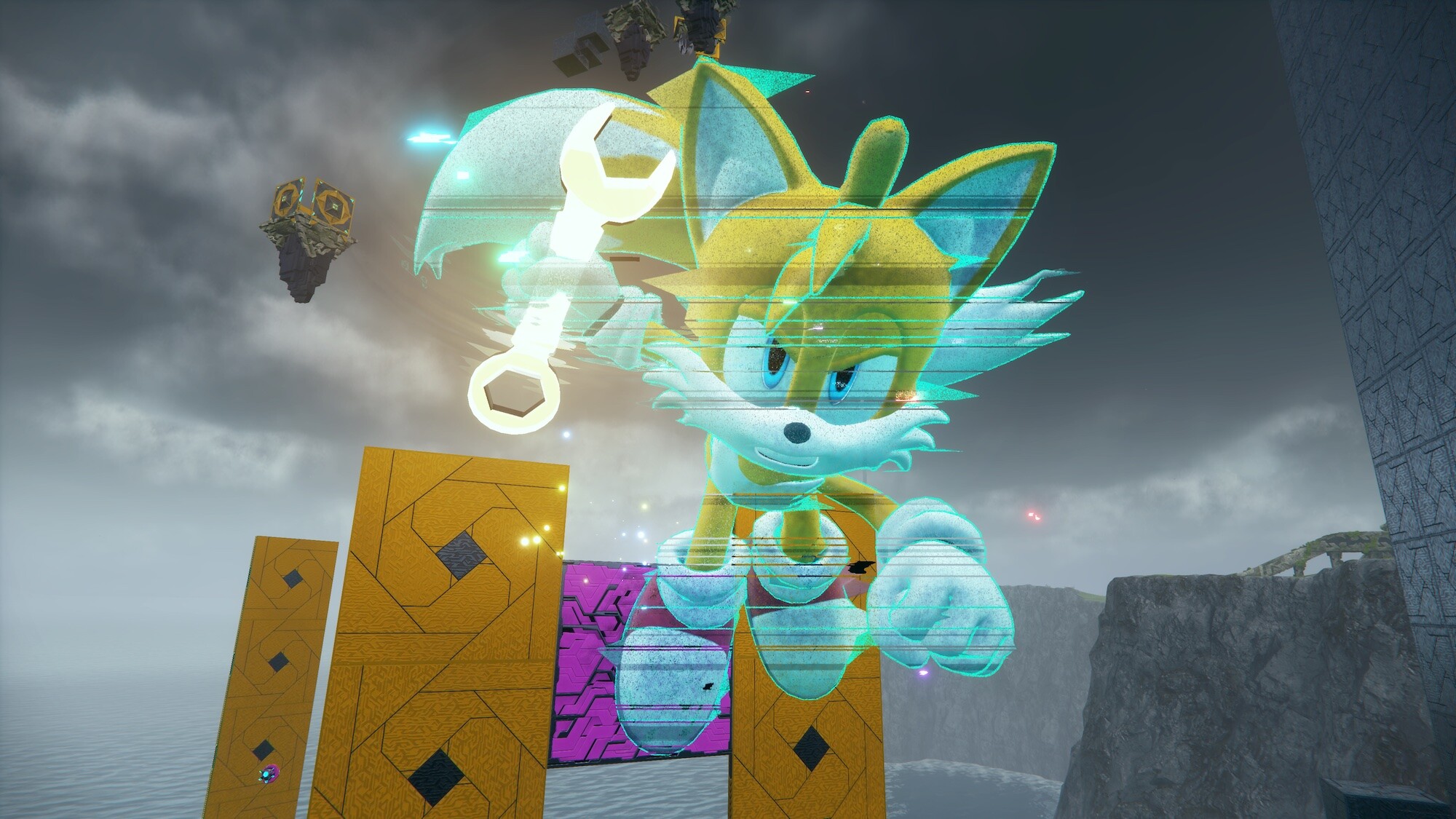
――Next, I’d like to ask about the final update, “Super Final Battle.” It’s the biggest update with a new scenario, additional playable characters, and more. What theme or concept was set during its development, and how was it created?
Kishimoto: At first, I was thinking of expressing our gratitude to those who purchased the product, but before I knew it, the idea shifted to making the update a rival to the retail version of Sonic Frontiers.
――That’s a powerful rival setting.
Kishimoto: And we wanted to show what happens when Sonic Team updates Sonic Frontiers for almost a year. There, the vibrant “MOD” culture was emerging as a rival, especially among overseas users. There were incredibly skilled individuals, and what we thought of making as fan service was already in motion, like, “It’s already working…” (laughs).
――What kind of MODs did you see?
Kishimoto: Characters other than Sonic being playable, new actions that we were planning for the update were already in motion, things like that. It was amazing (laughs).
If the users are already reaching that level, we can’t just release what they’ve already done as Sonic Team’s update. So, if the users are going that far, we thought we should exceed expectations and surprise them even more. As a result, it became like, “The product version is the rival?”
――”Super Final Battle” seems to have a considerably high difficulty level. Was this intentionally made difficult?
Kishimoto: Yes, that’s right. Basically, we assumed that players would engage with “Super Final Battle” after clearing the main story. There is a message at the entrance of the additional scenario indicating this.


Kishimoto: Also, in Sonic Frontiers, we introduced difficulty options for the first time in the Sonic series (Enjoy, Casual, Thrill). There are no disadvantages regardless of which one you choose, so I hope players can enjoy the difficulty level that suits them the most.
――Because not only the battle with enemies, but also the field during exploration changes quite a bit.
Kishimoto: That’s right. However, considering that there were more customers who were experiencing Sonic for the first time with Sonic Frontiers than we anticipated, and seeing opinions from everyone on social media, I do feel that we should have prepared a slightly more beginner-friendly difficulty level…
――I know that the time limit for the tower trials can be extended after a few failed attempts.
Kishimoto: Yes, that’s right. In the trials, if you fail several times, the time limit automatically becomes more lenient. It gradually becomes two levels easier after six failures, and when you reach the 12th failure, from the 13th play onward, it’s in the easiest state.
However, there might be customers who feel discouraged before playing 12 times, or they might still find it challenging on the 13th play. I think we should have made it a bit easier.
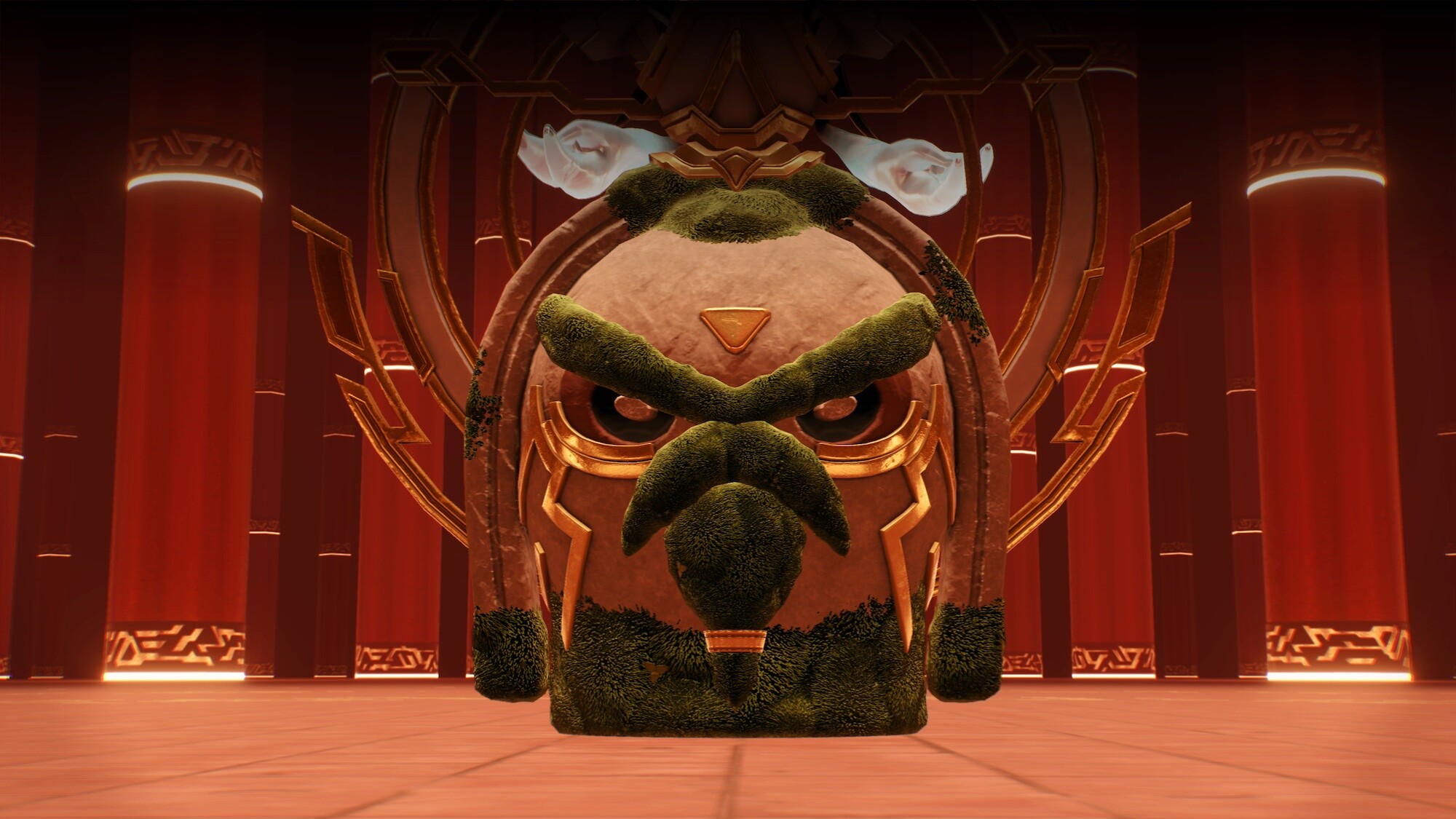
――I am wondering if Mr. Kishimoto could give some advice to the players who are struggling to beat the “Super Final Battle”. By the way, I haven’t been able to beat the last boss yet either…
Kishimoto: Generally, when players struggle with the additional scenario, it’s not because the enemies are tough or the attacks are relentless in terms of difficulty. I believe that wouldn’t be in line with the Sonic style.
Since this was a new challenge for us, we incorporated an element of “realization” into the difficulty. So, even with the final boss, once you realize the attack patterns, it shouldn’t be too difficult.
――Realization.
Kishimoto: The mid-bosses in the field are indeed stronger, but as you realize their patterns, you’ll find it easy to defeat them. In the Tower Trials, the more you get used to it, the faster you can clear them. So, like the traditional Sonic series, you can enjoy competing for speed and time.
However, the mid-bosses, puzzle challenges, and the Cyber Space stages are designed to be optional. Both in the main story and the open zone, we’ve created various ways to clear it.
However, training, in the form of “gaining new abilities through training,” is something we want players to experience, and that’s why the Tower Trials must be cleared as part of the story. So, while we didn’t aim for a punishing game, the intention might have been a bit too strong, and we reflect on that.
――Ms. Kawamura, as a producer, did you provide input on the game content and difficulty settings?
Kawamura: Not at all. In fact, even less so than during the main development.
Kishimoto: That’s true.
Kawamura: During the main development, we didn’t know how the customers would ultimately react, so I felt my level of input was necessary. However, after the main release, when we had a general idea of the reactions, I entrusted things to Director Kishimoto’s experience.
Kishimoto: However, I’m aware of the incredible overseas mods mentioned earlier. The sense of ‘we must surpass this as Sonic Team’ is very clear. Just changing the appearance of a character a bit wouldn’t surprise the fans, so meeting those expectations was crucial, and I think we managed to deliver on that.
――For example, each character like Amy having unique actions, such as using cards to glide?
Kishimoto: Exactly. In a unique approach characteristic of our Sonic Team, we needed to define ‘This is Amy’s action in Sonic Frontiers.’
Kawamura: As the director mentioned, just changing the appearance and allowing them to be controlled like Sonic is no longer enough. We can’t meet everyone’s expectations with that.
Kishimoto: So, it becomes a sort of showdown of wits between the customers and the Sonic Team in terms of how to go beyond mods and exceed expectations. We enjoyed that aspect during development, too.
Kawamura: When Amy appeared, I thought, ‘Wow, amazing! Truly professional!’ It might sound silly, but her action of using cards to ride like a bike is not something that comes to mind easily.
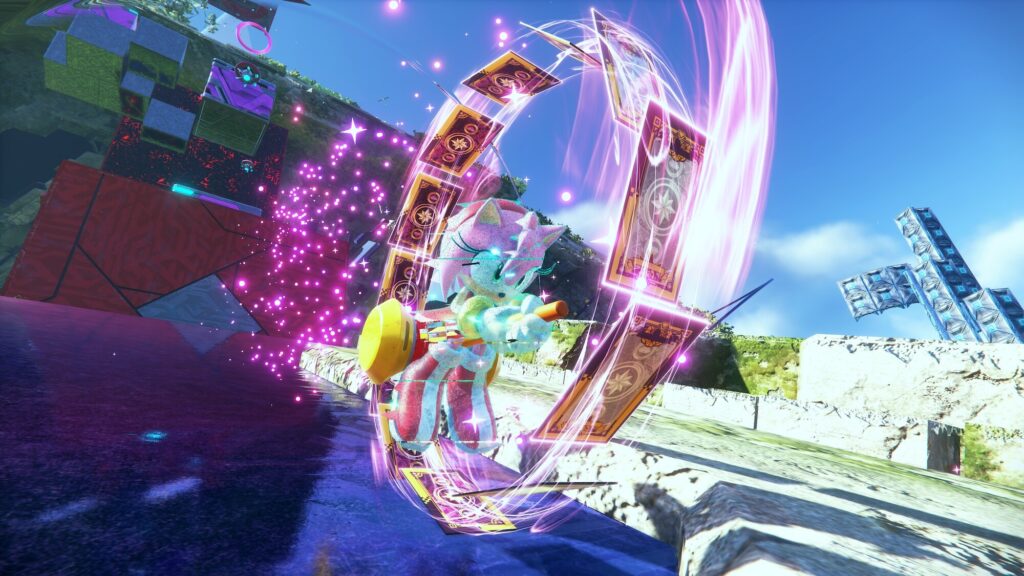
What is the Future Outlook for 3D Sonic Games?
――Finally, do you have any prospects for the future development of 3D Sonic, particularly in the direction of Sonic Frontiers?
Kawamura: I can’t provide specific details, but I believe that Sonic Frontiers has created a fantastic opportunity.
Both Director Kishimoto and I see this as a significant step in Sonic’s evolution into the next generation. While titles like Sonic Superstars in the 2D direction are excellent, we also aim to invigorate the 3D aspect, creating various titles. Please look forward to it.
――Thank you. How about you, Mr. Kishimoto?
Kishimoto: With Sonic Frontiers, we proposed the first step toward a new vision that is different from what we’ve done before. In response to this, I want to challenge Sonic games that get closer to that vision.
Ultimately, I hope to challenge top studios worldwide and see if our Sonic Team can deliver results, push boundaries even further.
――Thank you for your passionate words!
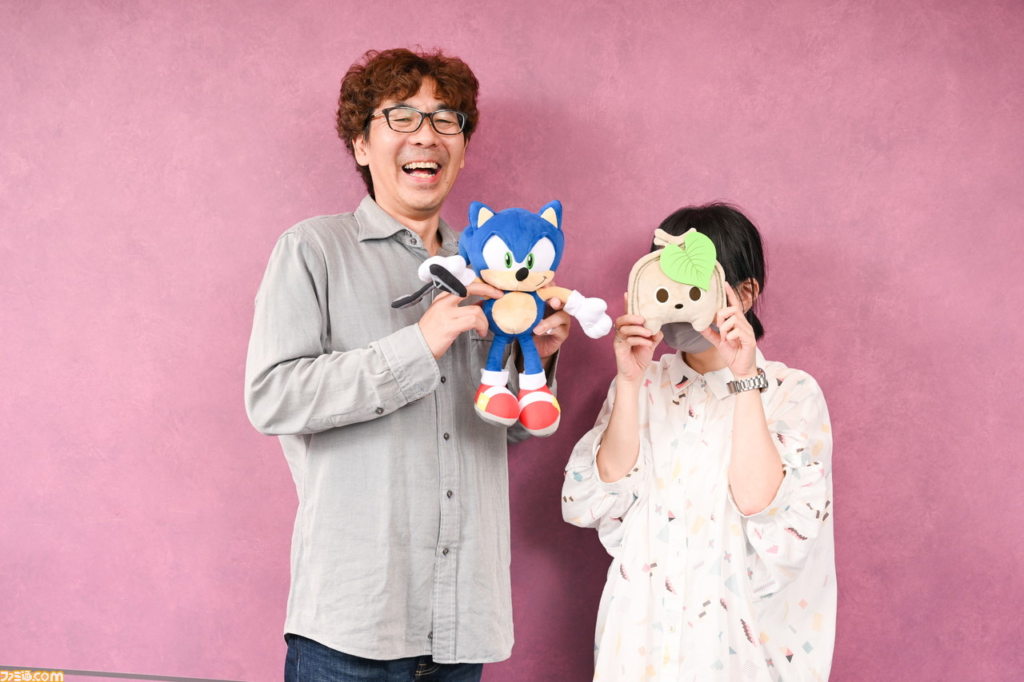
Source: Famitsu


